In April of 2006 I was privileged to join a group of pilgrims on a GATE (Global Awareness Through Experience) pilgrimage to Guatemala.
This is a photo diary of my experiences in Guatemala from April 5–15, 2006. In sharing this experience I hope to find deep down in myself some experiences that we all have in common.
Before, during and after my pilgrimage to Guatemala I read a book “Through a Glass Darkly: The U.S. Holocaust in Central America” by Thomas R. Melville. This is the story of Ronald Hennessey, an Iowan farmer, who, after returning from the Koran War a decorated veteran, became a Maryknoll missionary priest and labored among the peoples of Central America for thirty-four years. It is also a book of the history of Guatemala in the last half of the twentieth century, and the U.S.-sponsored genocide of the Mayan people of Guatemala. — Bob Graf
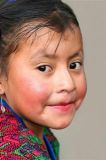
Photo by Jim Hendrickson
On this page… (hide) - Updates
- Day One, April 5, 2006
- Day Two April 6, 2006
- Day 3 April 7, 2006
- Day 4 April 8, 2006
- Day 5 April 9, 2006
- Day 6, April 10, 2006
- Day 7, April 11, 2006
- Day 8 April 12, 2006
- Day 9, April 13, 2006
- Day 10, April 14, 2006
- Epilogue: Journey Home
- Guatemala final thoughts
|
Updates
February 19, 2007 Update Fair Trade Coffee from Guatemala
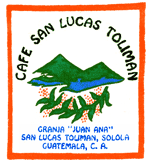
As you read below, when I was in Guatemala visiting a village called San Lucas Toliman, I had some delicious homemade coffee. I went to purchase a few bags to take home with me. It was only $7 for 17 oz of this shade-grown, organic homemade coffee. I said out loud that I wished I could purchase bags of this coffee in the USA. The pastor of the local parish was standing nearby and said: “You can”. I said, “How much will it cost me?” He said the same price as there, 7$ per 17 oz. In my astonishment I said something stupid like “is it fair-trade?” He laughed and said it is more than fair-trade. The coffee is shipped from Guatemala to the San Lucas Mission office in New Ulm, MN. All proceeds from the coffee go directly to the persons who produce it. I came home and ordered some. The one catch is that they ship you the coffee from E New Ulm, MN, and the bill includes the UPS or 3rd class postage that it takes. However, the last time I ordered I figured out that with postage it cost about $8 a pound. That is more affordable and more fair-trade than the coffee I had been purchasing. Purchasing it directly from the makers, with no middle person, is a wonderful experience. You can check it out for yourself at JuanAnaCoffee.com. I only wish I could do that for all of the wonderful items in the marketplaces of Guatemala.

Nov. 3, 2006 Update To Wisdom Through Failure
A friend of mine, Lorenzo Rosebaugh, whom you will meet in this diary, has returned from Guatemala to promote his memoirs To Wisdom Through Failure. It is his journey through life that has led him to prison, Brazil, El Salvador, Mexico and now to live in Guatemala and be with the poorest of the poor. It is a story of compassion, resistance and hope. Lorenzo has truly learned the “language of the poor”. You can order this book through Epica Press by using the form attached To Wisdom Through Failure. You can also contact me for a copy.
Day One, April 5, 2006
Flying out of O’Hare airport, as the plane reaches full altitude the sun begins to rise. Before I can take two pictures of it, there is light and I am on my way South to Guatemala. At a change of planes in Houston, I look for two fellow travelers who left Milwaukee early in the morning. They are not there. I later found out that their plane was delayed in Milwaukee and they ended up with an 18-hour flight from Milwaukee to Guatemala via Panama and Nicaragua. As the plane approaches Guatemala City I relax and try to open my mind and heart to this experience. I am going to Guatemala on a GATE (Global Awareness Through Experience) pilgrimage. (www.GATE-Travel.org). GATE is a cultural immersion experience allowing one to stand in solidarity, especially with the working poor, of a country.
Arriving in Guatemala, going through customs, exchanging some dollars for local money, I am met by Sr. Maria Des Jarias, one of the coordinators of our journey. On another flight arriving about the same time Ann, a sister of St. Francis, arrives. The three of us go by taxi to our hotel, in the heart of Guatemala City. There I meet two of the other pilgrims on this journey: Jim, a linguist and world traveler who has been in over 90 countries, and Sandy, a regular type of guy from Tacoma, Washington, in search of a change of lifestyle.
The street of our hotel is like all other streets in cities through the country, lined with doors. Behind the doors you may find a beautiful courtyard and building, or some shabby residence. Behind our door the casa is simple, modest and clean. It is kept clean by a young Maya woman, who seems to be in her 20’s. Jim talks in Spanish with her and finds out she is just a 15 year-old girl, who as we would find out, like many Maya women, has been aged by hard work and experience. Later we find out her brother, who at worked at the hotel for many years, has gone off with a group of men preparing to sneak into the USA to find a better way of life. Our coordinators who know him fear for his safety, since he has a handicap and is a very innocent type of person.
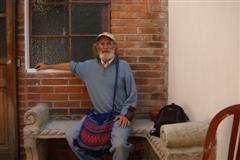
I have made arrangements to meet old friend Padre Lorenzo Rosebaugh that first afternoon. Lorenzo is an oblate priest whom I first met in Milwaukee in the 60’s at the Casa Maria House of Hospitality. We both were part of the Milwaukee 14, a group of men, priest, brother, layperson, who on Sept. 24th, 1968 broke into the selective service office building in Milwaukee, took the 1A draft files of the young men who would be soon called up and forced to go to Vietnam to kill and/or be killed, or face prison or exile. Outside the building in a small courtyard, we burned the 1A files with some homemade napalm, the chemical used to destroy the green lands of Vietnam. This act of civil disobedience was an act of protest against the draft and war in Vietnam. Before our trial and being sent to prison, Lorenzo, known as Larry at the time, married Pat (my wife) and me.
After prison, when most of us went on with our lives as before, Lorenzo started to live with the poor, first in a local backyard in Milwaukee and than after traveling to Brazil by bike, with the poor on the streets of Latin and South America: El Salvador and Guatemala, among other places. In between, he managed to return to the USA to visit friends and engage in other acts of civil disobedience leading to prison, one being the first protest at the School Of Americas, the USA training center at Fort Benning, Atlanta, which trains the military responsible for so much torture and killing of innocent poor men, women, children and religious in Latin and South America. His first time in Guatemala was spent in the north as an Oblate parish priest, traveling the many villages to serve the sacramental and other needs of the people. He was back in Guatemala this time, simply as a healer, to once again be present and to live and work with the poor and the sick.
As we talked and walked in the area, Lorenzo showed me the one hospital for the poor in the city, where he spends some time being a healing presence to the sick and dying. He told me about his works with the Sisters of Mother Therese’s order which literally takes the poor elderly left to die in the streets and brings them to a home where they can find a place to die with dignity. He also spends some time at a place for youth with AIDS. He still is the simple holy man that I knew in the 60’s, just living with and being present to persons in needs.
Warning from Lorenzo and our leaders told us of the great violence of this city, where gangs, trained in LA and elsewhere in the USA, roam the streets, and military with guns are present everywhere.
I went to bed this first night in my small room knowing that I was entering a new culture and would never be the same person because of it.
back to top
Day Two April 6, 2006
At breakfast the five of us pilgrims - Mary, Jim, Sandy, Ann, and I - gather with our two guides, Sr. Maria and Sr. Jan. Breakfast is a full one, and, as we would come to expect, included corn tortillas, fresh fruit, and black beans, along with other breakfast items.
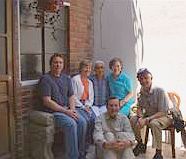
Julia Esquivel and 5 pilgrimsAfter breakfast and a few reminders (like never flush any paper, even toilet paper, down the toilet in Guatemala), our journey begins. Our first encounter is with Julia Esquivel, who comes to us at our hotel. At my first sight of her, it is clear to me that I am in the presence of a holy woman. She is elderly, wise, an accomplished poet, a political activist who spent 16 years in exile, and most of all a deeply spiritual person. Through one of our guides she asks us in Spanish to tell her a little about ourselves. We do. She, a storyteller, tells us her story by relating it to our lives.
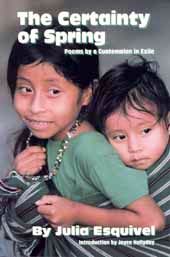
She tells of her, and the people of Guatemala’s, suffering and struggles, especially during the 36-year civil war that started in 1954 when the military (with the help of the USA government) overthrew the democratically elected government of Guatemala. Over her long and eventful life she has learned that all life is a gift of God, and that to live life to the fullest we must be all we can be. She told of how she had to struggle with the anger she intensely felt toward the treatment of her people. She has learned through difficult struggles the secret of interior peace - forgiveness of one’s enemy. She has learned how to pray for the leaders of her country and the USA, like President Bush, despite the suffering, torture and death they have brought into the world. She spent a lot of time in prayer with the words of Jesus on the cross: “Forgive them, for they know not what they do.” Jim explained to us later that the origin of the word ‘ignorance’ is from not knowing what one is doing. Violence is an illness that makes persons sick. The way to overcome violence is to return it not with anger and hate but with love, compassion and forgiveness.
She ended her talk by reading some poems from her three published books, all of which have been translated. She read the poem in Spanish and had one of us read the translation in English. We would hear from her again at the end of our pilgrimage.
Her three poetry books are: “Secrets of God’s Reign”, “The Certainty of Spring”, and “Threaten with Resurrection”. They can be ordered from any book dealer or from the publisher: EPICA. Here is one of her poems that is particularly telling to me and relates to this diary:
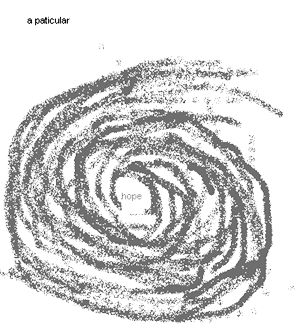
a particular hope by Peter Graf
Hope
In the darkest, most sordid,
hostile, bitter,
corrupt
and nauseating places,
you do your work.
That is why your Son
descended into hell,
in order to transform that which IS NOT
and to purge that which BELIEVES ITSELF TO BE.
This is hope!
(Threatened with Resurrection: Prayers and Poems from an Exiled Guatamalan, Julia Esquivel, 1982.)
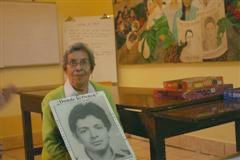
Emelia and Fernando GarciaAfter lunch we went to the office of GAM, a Mutual Help Group, for families of the many thousands of missing persons in Guatemala. We met with Emelia Garcia, the co-founder, whose adult son Fernando Garcia disappeared in 1984. She told us the story of her son’s disappearance on April 18, 1984. He was a union organizer who was picked up by the authorities one day, and like 46,000 others, just disappeared. The walls of GAM’s office are lined with pictures of missing persons, and like so many other mothers of missing persons in Latin and South America, Emelia has marched to find out what happened to her missing family member. Her son’s name was on a list of 123 persons that a Human Rights Group recovered from the government and which was sent to the group via the Secretary of State in the Clinton presidency. The final status, day they were tortured and killed, appears by some of the names on the list, but not by the name of her son. Other records and bodies are being discovered but for most families the pain of losing a loved one has no closure and they are ‘missing for life.’ Their office, due to threats, has been moved many times around
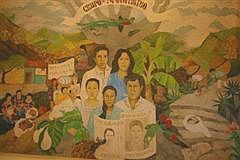
Guatemala City but remains active and alive, bringing lost families together and giving closure to others. The mural on the wall says a lot about the efforts of the group. Pictured are missing persons and on the top is a picture of the Quetzal, a rare exotic bird that is said to have lost its voice when the Spanish conquered the Mayans of Guatemala. The Quetzal is also the name of the local currency.
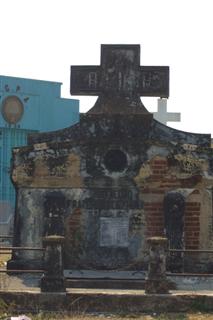
Old chapel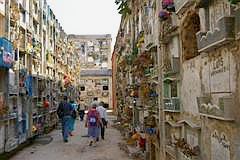
Walls of gravesAfter GAM we went by taxi to a major garbage dump where the very poor sift through the garbage to find food and other things to sustain themselves. To get an overview of the dump we went to a nearby cemetery that overlooks it. Families with money have little chapels built to house their deceased members. Remains of those with less means are just placed in concrete blocks on top of each other.
From the vantage point of the cemetery you could make out people walking in the dump looking for things. The contrast of standing in a cemetery of stone for the dead, looking out over garbage as a source of food for the living was striking.
From the cemetery the taxi took us down into the neighborhood around the dump. This is an area were the poorest of the poor live in dilapidated shacks. Even our taxi cab driver expressed concern about driving in the area, since he felt his cab was in danger, as a marked airport taxi with Americans in it. We finally got to our destination, a place called “Safe Passage.” We walked through some doors in this row of terrible buildings and suddenly we were transported into a world of beauty, light, laughter and hope.
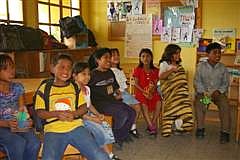
Safe Passage is a place of hope, education and opportunity. It is a new opportunity “for the families that scavenge at the Guatemala City dump searching for anything they can eat or sell.” It is a place for education for the children of these families, who until recently were allowed to scavenge the dump with their families. With its open, colorful surroundings it is place of hope. It is not a school but an “educational reinforcement program”. With the help of Safe Passage, each child is able to attend a public school for a portion of the day and then come to the center for a healthy meal, assistance with homework, vocational training, hands-on learning activates, and participate in a range of arts, music, sports and recreational activates. By their attendance, children can earn food and other items for their families. You can find out more about Safe Passage and how it serves the families who work the city dump on their web site: www.safepassage.org.
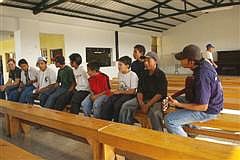
As we were looking around, a staff member came up to our group and said that we were wanted in one of the classrooms. There a group of young children had prepared some music to sing to us. Their faces were full of joy and gratitude. After a tour we were escorted to a roofed open gathering area. Our guide explained to us that the building was bright and richly decorated on purpose to give the children a healthy environment to learn in and discover a world outside of the poverty they lived in. In the open area a group of teenage boys, under the leadership and with the guitar playing of one of the staff, sang some folk songs for us. With both groups of youths we met, and from the staff, local and from around the world, we felt a sense of joy and hope.
back to top
Day 3 April 7, 2006
Today after another full breakfast we drove, after circling the Central Plaza and parliament of government, up the mountain to the Sta. Apolonia Orphanage in Quiche. I knew of this place, not only because it was started by local religious order Sisters of St. Francis, but also it was a place that St. Paul’s Catholic Church sponsored when I was a youth minister there some years back, and still sponsors. In fact, I had an opportunity to travel to the orphanage with youth when I was working at St. Paul’s but was unable to go because of summer school commitments I had at the time.
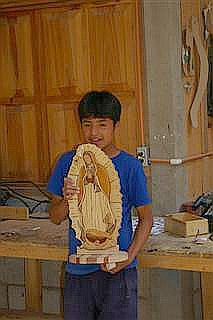
Sta. Apolonia is more than an orphanage; it is a self-sustaining village for about 100 children, some mothers of the children who lost husbands during the civil war, and staff members. All except the younger children were working in the fields that day but we did get to tour the woodworking, sewing and shoe workshops. In the woodworking shops the youth and staff make practical stuff as well as carvings to sell in the market. The clothes for the children are made in the sewing workshop and in the shoe shop they make their own shoes. The place is an impressive display of sustainable living.
We saw solar panels that Marquette Engineering students had constructed over spring break, which directly convert energy from the sun into energy to run the water pumps for the orphanage. The staff there was very grateful for these efficient pumps. We saw the women in the kitchen making the daily amount of corn tortillas, a staple of all Guatemalan diets.
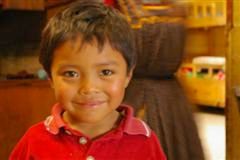
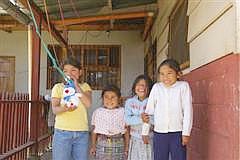
We went to visit one of the cottages where some of the younger children live, and there I discovered once again the universal language of children. By just a simple smile, putting my hand on my head, playing peek and boo with my hat I was able to communicate with the children. Although they were fascinated by the digital cameras we had, the most joy was brought to their face by eye contact or a funny gesture. I did not need Spanish to communicate with these young children. They spoke the same language that my grandchildren and I speak. After hearing about all the suffering and seeing the poverty of the day before, it was good to find joy and hope in the faces of these children. “Truly I say to you, whoever does not receive the kingdom of God like a child will not enter it at all.” (Luke 18:17)
After a full Guatemalan dinner - the noon meal being the main one of the day - we drove up the mountain, past volcanoes; sweat shops and shacks to a small Mayan village at Las Tampas. There we met the director of water projects for Caritas and were graciously welcomed by the Mayan villagers in their community gathering place - a bright, beautifully painted, open ended shelter. Sister Jan and we were officially thanked for the water projects that Sister Jan’s organization, Global Partners: Running Waters, Inc. (ssnd-milw.org/gprw.htm) had provided.
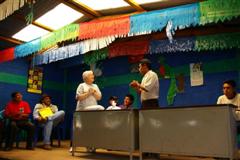
The women and children, colorfully dressed in traditional clothes, sat on one side of the aisle and the men, dressed in American style clothing sat on the other side. The men of the organizing committee sat on the stage with Sister Jan and the Caritas representative. The men on the committee thanked us in Spanish for the water project that had brought water to 26 of the 150 families of the village. A woman from the audience was called in front to speak. She spoke in the native language of Chichi, which was translated by one of the men into Spanish, which was than translated into English for us. She spoke about the long climb down the mountain that the women previously had to make each day to wash the clothes in the river, and to bring water for cooking and drinking back up the mountain. Her sincere gratitude came through without the two translations of her words.
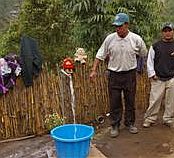
After the ceremony we climbed down a very steep hill to reach one of the houses, which had received a pump for water. One of the men proudly turned on and off the facet that now brings fresh spring water down the mountain to 26 families. The water actually comes down the mountain at night into holding tanks. Each family can use 60 liters a day, the international standard to conserve water. We were told that in warmer climates you are allowed more water and that Guatemala City it is 120 litters. (Do we have even a standard or ration in the USA?) This particular family, living in a very small house, had six children and was delighted to have water for cleaning, drinking and preparing food.
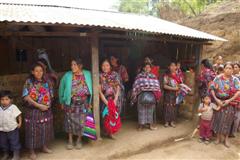
At the site I found myself naturally, before we left, going around touching persons, especially children. I stopped but then Sister Maria announced that it was a Mayan custom to touch each person when saying goodbye, so I continued. Some of the children, especially one child who seemed disabled, were shy at the beginning. However, by the time we were saying goodbye they were all smiles. Climbing back up the mountain was difficult and took our breath away. But it did not matter; the gratitude expressed by these villagers gave us fresh air and energy to move on in our pilgrimage.
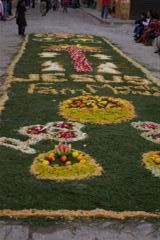
Next we drove to Chichicastengango, which would be our home for the next few days. There we found the preparation for the Holy Week festivities already in full swing. We had to take some detours to get to our motel in order to avoid running over the elaborate street art carpets that have been made of fruit, vegetables, flower petals and colored sand. They are called “alfombras,” and exist only for a few hours, until persons in the procession carrying floats (Andas) trample on them.
After settling in at the motel, I went with Sister Maria to purchase some bottled water at the store on the corner, and encountered one of the processions. It had floats (andors) of Jesus, Mary and saints, music by a live band, full of incense; children and spectators lined on the streets. Sister said it was mini procession, a prelude to the ones we would encounter in Antigua in Holy Week. Just a warm up.
On the way back from getting the water, we encountered a shoeshine boy named Emmanuel. Following Sister’s lead I had my shoe shined by this young boy. For about 60 cents, in
our money, I had my black sneakers shined like they were new.
In the courtyard, while waiting for the group to go to dinner, I met a young girl. We managed to find out each other’s name and had a decent conversation, although I know no Spanish and she knew no English.
back to top
Day 4 April 8, 2006
Before breakfast this morning I took a walk though the bustling market to the near by Cathedral. This church mixes Mayan symbols and sense of mystery with Roman Catholic traditions. Burning fires, lighted candles, lots of incense, statues of Mary and Jesus and saints were all part of this church. Leaving the cathedral I saw a group of young boys playing on the church steps. I smiled at them and they returned the smile. I caught the eye of one of the boys and gave him the slap on head gesture that I used with my grandchildren, as our secret greeting. To my surprise he slapped his head and returned the gesture. Like the children yesterday this act demonstrated there is a universal language that all children understand.
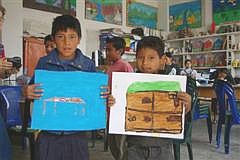
Our first stop today in the van was at Santa Cruz at Christian Action Guatemala (ACG) project. There we met a dynamic woman full of joy working with young children. She had originally come to Guatemala from Holland in 1979. In Guatemala she met her husband, an Irishman. They married and after a time in exile during the bloody suppression of the Mayan people, they returned. She runs a creative arts workshop on Saturday for 58 children. The workshop started as art therapy for the victims of the civil war in Guatemala and now has expanded to work with the children of these victims. The children were designing some wonderful wall hangings and proud to display them and talk with us about their lives and culture. Each piece of art came with a story. I purchased one 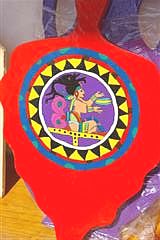
that told a story from the Madrid Codex of a serpent who supports the rain god Chica, who has a bowl of maize on his back. Many of the stories are from the “Popol Vuh” the sacred scriptures of the Mayan people. In one of the Mayan creation stories, the gods were seeking out material to create humans. After a number of failures they discovered corn worked. This explains why corn or maize is so important in their culture — source of food and life.
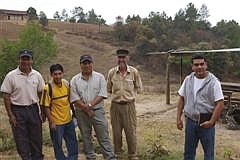
After visiting the art project we traveled up the mountains on some rough back roads to visit the organic farm that the dynamic Dutch woman’s Irish husband operated. There we were met by a number of men who are part of the organic farming movement that I am familiar with from my working with Growing Power here in Milwaukee. (Check on www.GrowingPower.org or my Growing Power diary site at HomePage } Growing Power Home Garden?.) They talked about
Tilapia ponds with water feeding the plants and compost from raising ducks. They had a worm-growing box for castings. I felt right at home here.
We had a picnic lunch at a local house in a nearby town where Sr. Jan used to be. It was a beautiful little house with indoor garden. The mother of the house is the director of a local middle school and was a catechist during the days when priest and nuns were pulled out of the area because of danger to their lives, leaving catechist like her as the leaders of the church. Her daughter was present. She is a pre-med student in nearby university.
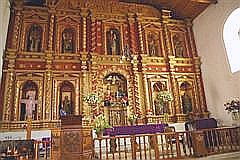
We than went to visit a church in a nearby town which was the site of terrible military persecution during the civil war. The present parish priest told us how the church had been taken over by the military and was used as a place of rape, torture and execution. We heard of massacres beyond human imagination of the Mayan people in this holy site. The priest took us to a room attached to the Church that was the main torture chamber. There is still blood on the walls of the people tortured and killed in that room. Many of the people that disappeared are still missing and more bodies are regularly found in caves nearby. Human’s torture of others unfortunately lives on. Now the room is a
shrine to the people who suffered and died in this village, among the over 200,000 civilians killed during the civil war facilitated by our government.
On a more positive note we saw at a kitchen on the Church grounds women baking bread for Holy Thursday where the custom was, the children had told us that morning, for everyone to share bread with those in the village, especially with those in need. The true spirit of life lives on despite the torture.
When we got back to our motel in Chichicastengango we were greeted by more processions and persons working to prepare the market for the next day.
back to top
Day 5 April 9, 2006
Today is Psalm Sunday and the festivities of Holy Week are going in full gear. The Sunday market in Chichicastengango, known in Guatemala as a major market, was even bigger than usual. The town center was overflowing with stands selling fruits, honey, clothing, baskets, everything possible under the sun. Many of the stands had similar items but all were busy from early morning on. Even the steps of the Cathedral were overflowing with vendors.
On the way to breakfast young boys wanting to shine our shoes surrounded us. Manuel was amidst them so I had him shine my shoes again. Another great job. All morning young boys were asking to shine my shoes. However, one of the young boys that had been with Manuel, later, seeing my shoes, smiled and said to me ‘Manuel’. I said ‘si’. Sister Maria had talked to Manuel about his shoe shining business. He told her he was expected to bring home a certain amount of money each day for his family.
I spend most of the morning roaming the market, sometimes with persons in our group, sometimes alone. It was a fascinating cultural experience. An elderly man and women were trying to make their money by guitar playing and singing. I asked for permission to take their picture. They were glad to oblige and I felt good abut donating to their basket.
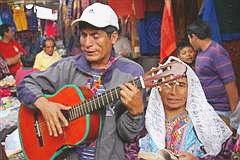
Everything was open to bargaining. In fact you were expected to bargain and the more interest you showed the higher the price would go. I was using some of my mother-taught Middle Eastern skill in negotiating price and doing okay till right near the end of our shopping time. Right at the end when I was using my bargaining skills to reduce the price, I made the mistake of using some 100 Quetzals, local money, instead 10 Quetzals (they do have the number 10 in one corner) so thus lost any great savings I had made. I went back to the vendor when I noticed my mistake but she was long gone, leaving her child and stand in care of an elderly women. It was a humbling experience with the only consolation that the extra money went to some needy family.
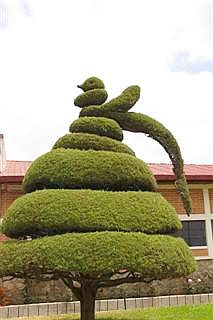
Also this morning we went to a nearby boarding school for girls called Anunciata. It is run by Dominican Sisters and is for poor Mayan girls from nearby villages and town who normally would not get an education at all. Many of the young girls come knowing only their native language and need to learn Spanish from the older girls and teachers in order to communicate in one language. Sister Donna, an IHM religious nun from North Carolina, showed us around. The school campus was beautiful and even had sculpted trees. The vision of the religious is that a school for poor Mayan girls should meet the higher standards one would expect in a private boarding school. They even had a major library with books, a rarity in Guatemala, although many of the books were textbooks.
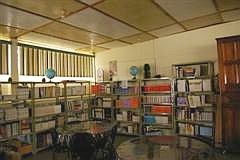
Sister Donna showed us a Power Point presentation she had made to present to funding sources. Her enthusiasm for the school was contagious. After the presentation we went to the sisters’ living area for some juice and banana cake. There we met the founder of the school, a Dominican Religious. The girls at the school had gone home for Holy Week.
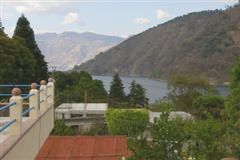
After lunch we drove to our new home for a few days, San Lucas Toliman. The town is in the volcanic region of the country on a very beautiful lake. With the warm days and cool nights it is the perfect climate for growing coffee. Some of us attended Psalm Sunday service at the local Catholic Church where the pastor, Father Greg, has been for over 40 years. The liturgy was briefer and much less formal than the one we could have attended in the morning at the Cathedral at Chichicastengang. To show you how informal it was, the pastor stopped on the way up the aisle at our seats to apologize to us for a little mix up there had been in our motel reservations.
After Mass we went to the church hall for dinner. The church is the center of much activity and commerce in the town and all the volunteers from various countries have three meals in common every day in the Church hall. There were workers, short term and long term, from all over the USA and the world eating together locally grown food and drink - a strong sense of international community.
Tonight at our daily reflection of the activities of the day, Jim got into talking about some of his high adventures in traveling and somehow mentioned a web site dedicated to outhouses. This discussion led to much laughter and made me think that I should write more about the characters on this pilgrimage. But I was too tired at the moment, from another long day, to do much about it.
back to top
Day 6, April 10, 2006
During breakfast at the community hall at the parish, we noticed that off to the side young men were sorting out coffee beans. Only the good beans are used for Café San Lucas Toliman. The cost of this excellent coffee is $7 a pound (17 oz.) with all the proceeds going to growers and processors there. In the USA you can order on the web at http://www.juananacoffee.com/. The cost is still $7 but you need to pay for shipping from New Ulm, Min. where Father Greg is from. It is still a good deal for organic, shade grown quality, more-than-fair-trade-coffee.
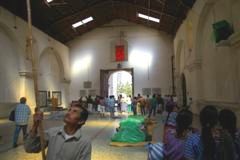
After breakfast at San Lucas Toliman we got in the van, and our driver Eladio took us to a nearby village that has suffered a lot during the civil war. The Church was being cleaned but we still got a good look at it. We saw the vessel in the church that contained the heart of Father Stan, the parish priest who had been martyred at the site. We visited the rectory now made into a chapel commentating Father Stan and others who were killed by the military during the civil war.
In the courtyard of the Church there was a lot of activity as people were scurrying around to get ready for the great feast of Good Friday. Many of the children wanted their picture taken. A few asked us for money, which was not the norm in Guatemala.
From there we traveled up the mountain to a small village that was devastated by mudslides after 12 days of rain from Hurricane Stan in Oct. 2005. We went to a refugee camp where families of 7 or more live in a small tin one-room house provided by UN. Smaller families need to share a house. The people in this Mayan village speak Tzutujll. We had a woman with us who translated the native language into Spanish so our guides could translate into English for us. We went into the translator’s tin house where she lives with her family of seven. The seven of us could hardly fit standing in her house. Her daughter was in one corner weaving.
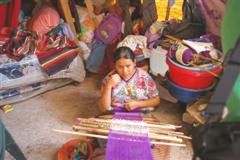
Next to the tin hut camp, men are working building concrete and stone homes for their families. We were told that the Government of Guatemala responded better to Hurricane Stan that our government did to Hurricane Katrina in New Orleans. (I could not believe that statement until now - I just spent last week, July 11th-18th, 2006 in New Orleans, and did not see any government response, not even one dump truck to pick up the trash strewn all over the streets).
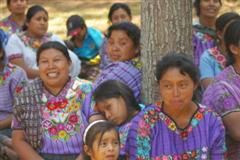
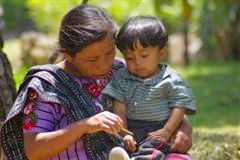
The mudslides of 2005 came down the mountain in 3 waves, in the middle of the night, without any warning. About 500 persons were buried in the village, which was declared a vast burial site. We were told that the women of the village were waiting near-by in an area called “Peace Park” to talk with us. There we found about 40 women in traditional garb, most with young children. They told us, through the two translators, the tragic stories of the storm and how they had lost everything. They said we could take pictures of them and were delighted that we would simply listen to them. A Native American Drexel Sister was traveling with us that day. She thanked the persons for sharing with us and told them a little about the suffering of Native Americans in the USA. We left some of the medical supplies we had brought with us there for the solidarity clinic that was serving the people in the village.
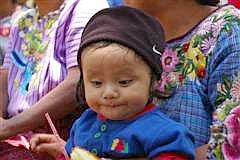
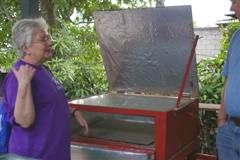
After lunch back at the Church we went to a Progresso Solar Oven project started by one of our guides, Sister Jan, when she lived in this area of Guatemala. In a land where people cook with wood fires and there is a limited supply of wood available, these solar ovens are a unique and effective way to cook.
After returning to the parish we had a chance to shop and walk around the village. There was a lady near the Church, who was a friend of Sister Jan, who sold some Guatemalan hand woven colorful shirts with pockets. I purchased two of them at a terrific price by American standards. Also there was a young boy selling pens, into the fabric of which he wove any name you wanted with lightening speed.
Around 4 or so, before dinner, we gathered in the Church hall for Father Greg’s talk to all the visitors on Globalization. He talked on Globalization and Economy. You can tell this was a talk he had given many times before, as he explained complicated issues in a straightforward and simple manner. He talked of neo-liberalist capitalism, the culture we impose of the people of Guatemala as only one of 5 ways of culture:
- The first type is that hunter and gathers, the way of primitive people.
- The next one he called Horticultural, where people used tools.
- Advanced Horticultural where more advance ways of farming are used.
- The next was the Agrarian farm culture where equipment was used but there were fewer farms.
- Then there is Industrial culture where manufacturing is prime. This is the type of culture of neo-liberalist capitalist like in Japan, Germany, USA, Canada France and Russia.
He felt that if the Mayan persons were allowed to form their own culture they would choose number 3, Advanced Horticultural. This explains why there is such a strong cry for land amidst the Mayan people, although most land is still in the hands of a very few Spanish families who descended from the original conquistadors. He explained the Mayan people know God through nature and have a horizontal relationship with God. We “gringos’ tend to look at God in a vertical relationship. Because of the imposition of our culture on the Mayans, although they live in a land of plenty and good natural resources, 80% of the people live in dire poverty. This way of living is kept in place by organizations like the World Bank, nations like the USA and enforced in Guatemala via the landowners using the military.
With our realization that we are all brothers and sisters in one God he said that we should work to respect and dignify all persons no matter what type of culture they desire and want.
After dinner we had a chance to purchase some hand-made items by the local coopers and some homegrown coffee. I purchased a beautifully small bag with many zipper pockets that I carry with me everywhere.
Back at our motel we had a visit from a group that carves spoons and other utensils from wood from coffee trees and the trees that shade them. They told us the story of how they started the business and keep it going.
back to top
Day 7, April 11, 2006
This morning started with a brief walk down to the lake to watch the Mayan women do their daily wash. They have used this same method of rocks and water for thousands of years. Even now in some villages they will have a common area for the women to wash their clothes.
After breakfast we visited the Daniel Mauser library, which is part of the Church/school/ co-op complex. Daniel Mauser was one of the youths shot in the face at the Columbine school shooting in Littleton, Colorado. His family had given the money to make it a true ‘children’s library, complete with children’s picture books, something you rarely see in Guatemalan villages.
Next we visited the nearby forestry refurbishment project. This is an important project since, as I mentioned earlier, wood for cooking is heavily relied upon and scarce. The manager of this project showed us a small bottle with thousands of tiny seeds, each of which
will grow into a gigantic tree for wood and shade. While at the forest project we met a woman who was looking to buy a tree to plant as a memorial to a 12-year boy who had been killed the day before when he fell from his bike under the wheels of a speed truck. (This was the third time this truck driver had run over somebody.) She and husband were starting an environment educational center. She was really interested in Growing Power (www.growingpower.org) and we exchanged email addresses.
Nearby we checked out the bee farm and got an education in honey making.
We traveled by van to the nearby Christian Foundation for Children and Aging (CFCA). I was familiar with this foundation from my time at a school in Monterey Mexico for very poor children. The school was partially funded by this foundation, which is based in Kansas City. A former Jesuit and former Christian Brother started it. CFCA is a lay Catholic organization committed to creating relationships of mutual respect between sponsors in the United States, and children and aging persons in 26 developing nations. One of the founders Bob Hentzen is located in San Lucas Toliman. For more information on this worthy project and how you can sponsor a child or elderly person check this site: http://www.cfcausa.org/. We took a tour of the facility, mailing center, farm and garden.
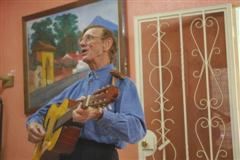
At the end of the tour Bob talked with us for a while and sang with his guitar two folk songs he had written. He was a very inspiring person who, with his wife and family, live in this small village and help to direct this major ministry.
After lunch we celebrated Mary’s, one of our companions, birthday with cake and song. More volunteers were coming in to work in the town as we were leaving. Father Greg - scholar, pastor, and friend - has made quite a difference in his over 40 years of ministry at San Lucas Toliman.
We got into the van and traveled to Antiqua, the final city in our tour. Antiqua is the one place in the world to be during Holy Week. People traveled from all over Central and South American to be in this ancient city during this week. The population explodes for this week, and it was only because of Gate’s reservations and reputation that we had rooms in a small hotel with a beautiful courtyard in the heart of the city. We walked around the small town as it prepared for the biggest celebration of the year, Good Friday. We went to a nearby restaurant for dinner. Afterward some of us went with Sister Jan to a nearby warehouse store for a little shopping. Back home I am not a shopper and in fact get a headache if I am in a mall for more than an hour. However, in a third world country, which is to me like being in never-ending third world shop, I love to buy. It is sad that all the small vendors in the markets and stores in Guatemala cannot sell their stuff directly to Americans. That would really be fair trade. Their homemade goods, even with shipping expenses, would be inexpensive in our country, sell well, give us true low cost and be profitable for the people there. But the major corporations like Wal-Mart and our government say no. We must purchase our low cost goods at a higher prices (many hidden from us) from low-paid workers in sweatshops. Someone, neither us nor the people of Guatemala, is making and saving a lot of money in this deal.
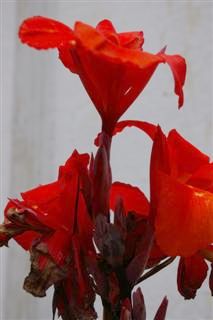
I was very tired that night but still able to write this in my diary:
Peace runs deep in the Guatemalan soil,
But the bloody wounds of violence and greed
Have left its scars on the land.
back to top
Day 8 April 12, 2006
After another full breakfast at a neighboring restaurant, we left for Guatemala City to meet once more, near the end of the trip, with Julia Esquivel - poet, political exile, wise woman. This time it was at a Mennonite Mission. She asked us what our thoughts were about Guatemala at this point of our pilgrimage. Some mentioned the extreme suffering the Mayan people had endured, some mentioned the signs of hope we had experienced in the culture. I mentioned the experience of joy and peace I had seen in the faces of the children. They were like children everywhere, present to the moment, full of hope and imagination.
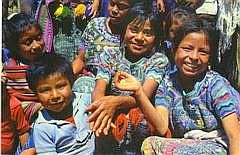
She told us of the wealth of Guatemala, the natural resources, the spirit of the people. Yet the people live in extreme poverty. Why? To her the root of the extreme poverty was the ideology of capitalism (call neo-liberal capitalism in Latin America) that has been and is being forced on the people. The rich in American and the few in Guatemala, who put their stock in consuming and collecting more stuff are at the heart of the problem. This system of production and consumerism that is kept in power by military force kills over 40 million persons a year in the world, according to her.
An example is that a few years ago gold was discovered in Guatemala. A USA company came to explore and exploit, with the Guatemalan government’s blessing, the gold.
There are, however, signs of hope all over Latin and South American. Some countries like Bolivia recently are saying NO to this form of economics. Secretary of State Rice called the new president, a former farmer, because he will no longer cooperate with the USA economics in Bolivia that were suppressing his people.
All over Latin America there is great injustice. In Guatemala 70% of land is owned by 2% of the people. While people worked for pennies, 25 cents in 1977 for farm workers, their employers like United Fruit Company of USA paid no taxes. What started in 1954 with the USA-led overthrow of the democratically elected government has snowballed with tragic results till this time.
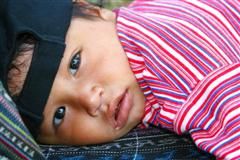
Photo by Jim HendricksonWe all need to resist in whatever way we can, she said, these forces of evil, but not by return of violence but by words. We must choose our words carefully and speak them at the right time. Words we say, according to Julia, must be the words God wants us to say. Words are like seeds that when planted and nourished can grow into mighty forces bringing God’s reign down on earth.
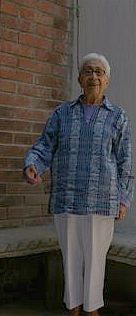
Julia EsquivelAgain we were blessed with words of wisdom from this elder of society who suffered much, spent 16 years in political exile, yet was full of hope and expressed gratitude. She reminded me of another wise elderly women I had the blessing to have as my teacher at Loyola in Chicago, Sister Irene Dugen, a cenacle religious who was teaching a course on the Spiritual Exercises of St. Ignatius for the last time. When she spoke her carefully thought out words, like Julia Esquivel, you felt like they came from deep inside her. That night I wrote these words in my diary:
A story of two women,
Julia, wise old woman,
Sr. Irene Dugan of Guatemala,
Who has deeply lived and
Knows when to speak,
When to be silent,
When to be outspoken.
From meeting a holy woman,
How will I change,
Allow the spirit to work in me.
It was after her talk that I decided to call this diary “Buried in Guatemala.”
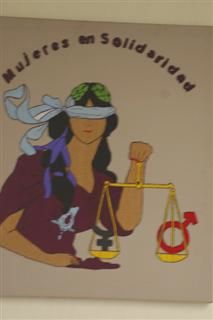
After lunch at an American-style fast food restaurant, we traveled to a very poor neighborhood outside of Guatemala City. We visited The Association of Women in Solidarity (Associación de Mujeres en Solidaridad - AMES) and with Rosa Escobar. She was the same person who escorted us at our earlier visit in the village that had been destroyed by Hurricane Stan the previous October. She gave us the history of the clinic, how it was born out of the severe suppression of the poor (especially women) by the government. She told us how the whole clinic was a miracle of God, and how time after time, when they were ready to collapse and die, someone one would show up with gift to keep them in existence. As we were talking they were facing still another crisis, as one of their main benefactors was soon to discontinue funding them. Yet she was full of hope and enthusiasm as she told us of the work in the clinic with the poorest of the poor, in the largest squatter settlement in the country, and with the woman who were forced to work in sweatshops to survive.
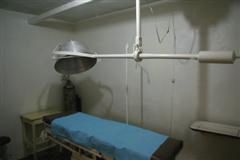
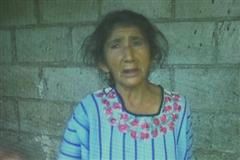
We saw a video the clinic had made about a particular woman who worked in a local sweatshop 14–16 hours a day every day for about $200 a month. Because of the working conditions the woman’s health had deteriorated but she had to continue working whenever possible so her children would have enough food and some shelter. We took a tour of the small clinic and the primitive operating and birthing rooms.
For more information on the condition of women and sweatshops in Guatemala see the following Human Right Watch page: http://www.hrw.org/reports/2002/guat/guat0102A.jude-03.htm
We traveled back to Antiqua, which was now overflowing with people from all over Central America as Good Friday was approaching. That night the pace of the processions with andors (floats) walking over the street carpets (alfombras) was increasing. The friendly parrot in the courtyard of our motel was there to welcome us back.
Day 9, April 13, 2006
Today is Holy Thursday. We started the day by going to breakfast at the house of a weaver in a nearby village. We had a major breakfast at her in-laws house next door and then went to her house to see her work. The GATE leaders had gotten to know this family since her husband used to be the driver of the van that we use. Almost all buses, taxis and van services in Guatemala are owned by small business, individuals who have a few vehicles and employ drivers. Currently her husband is trying to get to the USA for work legally. Most men do not bother to try the legal process and just come to the USA to find work to support their families.
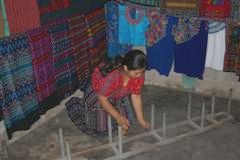
At this master weaver’s house she showed us the simple process by which women weave beautiful (and sometimes large) items. The weavings take time and patience. For example the simple tabletop cover I purchased took three months of work. Another one she showed us was one she made for her mother-in-law, as is the tradition for her wedding, and took a year to complete. She specialized in doubled-sided weavings, where both sides have the same image, which takes even more time. Girls, like her daughter, learn the process from their mother. There is no pattern — all is kept in the head. I thought of Gandhi in India encouraging all his followers to take up weaving all their clothes as a way to achieve independence and develop the spirituality of nonviolence.
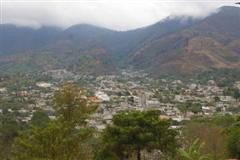
This village is in a valley, and the view from the mountain overlooking it is thrilling. On the way back to Antiqua we stopped at the best hotel in town, where the rich stay. President Clinton and the President of France supposedly stay there. What a contrast the hotel was to the simple house of the weaver.
We also stopped at St. Francisco church where some of us would attend Mass at 5pm. The Church and streets were alive with everyone preparing for the celebration of Good Friday. Processions and street carpets (alfombras) were everywhere.
After lunch we had some time off. Another pilgrim Mary and I went the to the main market which was nearby. There were so many shops, many of them with similar items. I purchased more stuff. Normally I do not like shopping (or even worse, bargaining, which you must do at these shops). In the USA I get a headache if I stay too long in a mall. However, in a third world country, where most things are made by the person you are purchasing them from, and are inexpensive, I enjoy the experience. Also I think my Middle East heritage kicked in — looking for a good deal and then bargaining. Whatever the reason, I was energized by the shopping experience and came back to motel with lots of stuff to pack.
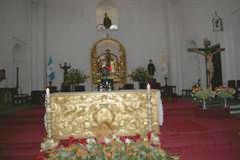
Four of us went to the 5pm Mass for Holy Thursday. The mass was long, full of ritual with lots of incense. One of the woman in our group said she wished she had not come, since it was so long and in a language she did not understand. Another women in our group, although she also did not understand Spanish, thought the whole experience was inspiring. I was somewhere in between these two women in my response.
After Mass, three of us went out for dinner. We did not have much time and ended up going to a place where we already had been with the group for lunch. Like all places it was busy, but we found a women who spoke excellent English, took our orders right away and sped up our service. It turns out that she is from Antiqua but her mother was from Texas and taught her English as a child. She picked up the English but not the Texan drawl.
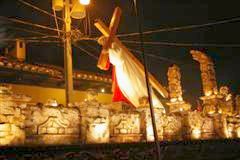
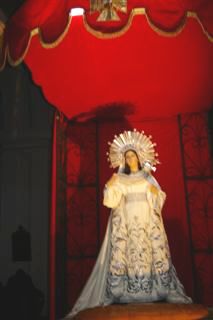
We got back to the motel on time for our group trip to a nearby church, but before we could leave another procession came by. Finally we were able to walk over the gardens inside the Church where one of the man processions for Good Friday was going to start at sunrise. The statues in Church were beautifully clothed with special clothes made just for Holy Week. We were told that if we wanted to be present at the Good Friday service at this Church we had to get up at 4:15am and be ready at the Church doors when they opened. I decided I wanted to be a part of this early morning service so after arriving back at the motel I went right to sleep. I had no trouble sleeping even though the processions and the celebrations lasted all night long. I was tired. I had discovered a people with a long history, a people that have suffered and been repressed yet have maintained their spirits and a sense of peace. Good Friday in Antiqua was the epitome of the spirit of the people of Guatemala and I wanted to be present to it fully.
back to top
Day 10, April 14, 2006
Today is Good Friday, the major day of celebration for the people of Guatemala - bigger than Christmas or Easter for us in the USA. I got up early to attend one of the first processions of the day at the Church we attended last night. It was still dark when I got to the Church and joined the group of persons waiting at one of the side doors. When the doors were opened I walked in with the crowd to find that those who had waited at the main doors for the Roman Guards to let them in already occupied all the pews of the Church. People who had waited with me were going in all directions. I decided to go with the persons who were walking to the front of Church to be behind the first anda (float), that of Jesus carrying his cross. Rather than watch from alongside, I joined the persons who were marching behind this first anda. As we marched the streets were crowded with onlookers, but surprisingly few joined us in the procession.
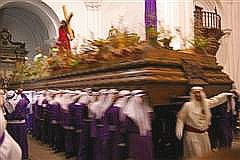
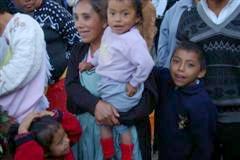
After marching for a while I made friends with an extended Mayan family who were also in the procession. I got to know, without using any words, most of the family members, especially Hubertus, one of the young boys in the group. The andas were heavy and it took many men and women, changing shifts, to carry them throughout the streets. After an anda trampled over an alfombra (street carpet) we were free to pick up the flowers that had shaped it. I started to collect a bouquet of dried flowers that lasted for a few weeks after I got back.
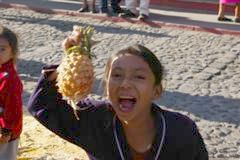
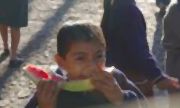
At one point Hubertus and the other children ran ahead. I did not understand why until they returned with cabbage, watermelons, peppers and other fruits and vegetables. They knew that the andor was going over an alfombra (street carpet) made of fruit, and that after the andor passed it would be okay for them to take the fruit and vegetables. The parents and all of the family were overjoyed with the bounty brought back by the children. The parents and elders stuffed some of the vegetables and fruit in bags they had brought with them and the children were allowed to eat pieces of watermelon and other fruit. One of the girls offered me a red pepper, which I declined. Later in the procession I was offered a rutabaga, which I also declined.
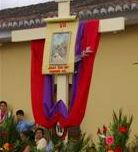
My newfound family friends dropped out of the procession a few blocks later. It was time for them to go home and enjoy the fruits and vegetables that had gathered. I continued on. When we would get to a station of the cross, marked by a sign on the street, we would stop to pray. The procession went on and on, winding through the streets of Antiqua. I understand there are three such processions going on the same time on Good Friday in this small city, but they are so well organized that they never cross each other. After parading for five hours in streets I was not familiar with (and only making it to station eight of fourteen), I finally saw the Church where we had started. I decided to leave the procession soon, since from there I could find my way back to the motel for our 11 am gathering. It was at this point I heard a couple speaking English. They were from an English speaking country and had visited Antiqua before on Good Friday. They told me that the procession would go right to the block of our motel. So I stayed with it till that point and made it back, tired but grateful.
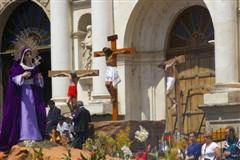
After some time of common reflection and lunch, we had the afternoon off. I decided to wander the streets, check out other processions, anda, markets and celebrations of the day. . At the town hall I found they had erected three crosses, commemorating Jesus and the two thieves who were crucified with him. I noticed that the skin of Jesus was dark like the skin color of Mayan people. However, the skin color of the two thieves was white. I thought that was appropriate.
I made my way toward the final procession of the day at another Church at 3pm to commemorate the burial of Jesus. After visiting inside the Church I decided to wait outside in the square for the procession to begin. There I found lots of good food and drink, music and an aura of great celebration. Waiting for the anda of Christ in the burial tomb I made friends with a young couple and their small child. Again this was all by eye contact. The couple was very young looking in my eyes, and the father had a scar on the side of his face that I could see. At first I worried about making eyes with his young wife and child, but as soon as he turned to face me he was all smiles and greeted me with great warmth and affection.
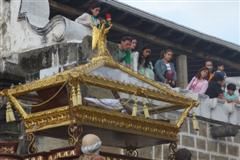
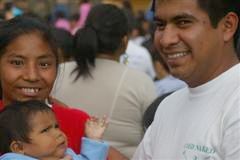
Finally, the burial anda emerged and I, with many others, started to take pictures of this final sight of the buried Jesus. After the anda had passed our point I noticed that I had only one picture left on my digital camera, after having taken hundreds of pictures and filling up two disks. I asked the family of three, in unspoken language, if I could take their picture. They said yes and I did. Afterward my camera read: “Memory disk is full.” There would be no more pictures, but my last two, of the burial of Jesus and the young family smiling, said it all for me: about the death and life of the people of Guatemala
back to top
Epilogue: Journey Home
It is Saturday, April 15, and I begin the long journey home from Antiqua, Guatemala to Milwaukee, Wisconsin. When I was in Appalachia on a youth mission trip I learned a local way to say ‘goodbye’. It was “Come Home with me.” That was my Goodbye to Guatemala as I traveled in the van for the last time to the airport in Guatemala City.
It was Holy Saturday, the day between the sorrow and death of Good Friday and the joy and blessings of Easter Sunday. A deacon once told me that this time was one we skipped over too fast. He said that most of our lives were lived in this ‘in between time’, between moments of sorrow and moments of joy. The people of Guatemala, I think, live in this time. That is why, although they have been so suppressed, tortured and killed, they can still smile. They celebrate the death and burial of Jesus because they know in their hearts the Resurrection will come. This is their hope.
During the whole trip I was so careful of safeguarding my money, passport and airline tickets. This is why I was so surprised when a fellow pilgrim from the Milwaukee area walked up to me in a gift shop in the airport and asked if I would like to purchase a passport and airline tickets. I thought he was joking and reached in my shirt pocket for them. They were not there. I had left them in the men’s room on the sink counter when I was washing my hands. A Guatemalan man had found them and gave them to an American looking male sitting outside of the men’s room, which happened to be my fellow pilgrim.
I had to transfer planes in Houston for a flight back to O’Hare. My plane coming into Houston was terribly delayed. While waiting for hours I watched some American TV, something I had not seen for 10 days. My home town of Milwaukee made the national news for an event on Good Friday. It was the news that the police officers, who had publicly beaten without cause an African American man, were found innocent of all charges. The other police officers that witnessed the brutal beating put up a “code of silence” that allowed the officers charged to be found innocent by an all-white jury. The news was a reminder to me that we have our own crimes against minorities to deal with in our country.
Since our flight was late out of Houston we did not arrive at O’Hare field till near midnight. Churches around the world were celebrating the hope of the Resurrection by lighting candles and piercing the darkness of death with the rays of light.
I had a window seat and hoped to photograph a sunset as I had done with the sunrise coming out of O’Hare airport ten days earlier. But during the flight I had switched my seat to the middle one so that a mother could sit next to her son, and now it was well past sunset. However, as we were approaching the airport I could see the lights of the city of Chicago. They became my Easter vigil candles and I was able to photograph them.
Yes the people of Guatemala have suffered greatly and were still being oppressed. The most celebrated day of the year was Good Friday, when one like them, a poor peasant living in a small, oppressed country, had died and was buried. Yet they had kept their spirit and their hope. The city lights below my plane lit up the darkness just as their smiles lit up Guatemala.
I am home but will always remember my pilgrimage to Guatemala. The spirit of the people, especially the children, has touched my heart forever. I would encourage all of you to have a similar experience in a third world country. Contact Global Awareness Through Experience (www.GATE-Travel.org) for more information.
Guatemala final thoughts
This diary, “Buried in Guatemala” is now done. I do keep a daily diary called: “Diary of a Worm in a Home Growing Power Box and Garden,” at Growing Power Home Garden. This diary is all about daily life, mostly as it relates to my Growing Power Garden and Box, powered by worms. If you want to know more about Growing Power or want to read some of my reflections on daily life, check it out.
Here is a poem by Julia Esquivel that describes many persons who have hope even though they suffer repression.
I am no longer afraid of death,
I know well
its dark, cold corridors
leading to life.
I am afraid rather of that life
which does not come out of death,
which cramps our hands
and slows our march.
I am afraid of my fear
and even more of the fear of others,
who do not know where they are going,
who continue clinging
to what they think is life
which we know to be death!
I live each day to kill death;
I die each day to give birth to life,
and in this death of death,
I die a thousand times
and am reborn another thousand
through that love
from my People,
which nourishes hope!
— Julia Esquivel in “Threatened with Resurrection, Prayers and Poems from an Exiled Guatemalan”
back to top